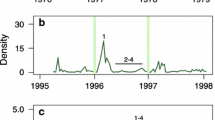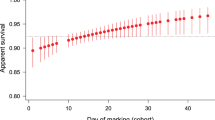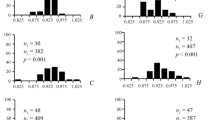Abstract
Glossina or tsetse flies, the vectors of sleeping sickness, form a unique group of insects with remarkable characteristics. They are viviparous with a slow rhythm of reproduction (one larva approximately every 10 days) determined by the regular ovulation of alternate ovaries. This unusual physiology enables the age of the females to be estimated by examining the ovaries.
The resulting ovarian age structure of tsetse fly populations has been used to develop research into the demography of tsetse flies. Several authors have proposed methods of estimating population growth rates from ovarian age distribution data. However, such methods are applicable only when the growth rate (λ) is equal to 1 (i.e. the intrinsic rate of increase r is equal to 0). In fact, in this type of estimation, the adult survival rate a (or equivalently the mortality rate) cannot be dissociated from the growth rate.
Other independently determined demographic parameters must be used to remove this lack of identiflability. We have built a matrix model of the dynamics of tsetse fly populations which enables the growth rate to be calculated from the pupal survival rate, the pupal period and the adult survival rate. Assuming that the age-groups of the population studied have reached a stable distribution, it is possible to calculate the probabilities for the observed sample of belonging to each of the age-groups, to construct a likelihood function and thus to obtain an estimate of the ‘apparent survival rate’ β = a/λ If the pupal survival rate and the pupal period are known, a and λ can then be calculated from β.
The application of this method to data collected for over two annual cycles in a savannah habitat (Burkina-Faso) showed a high overall stability in the populations of Glossina palpalis gambiensis. Seasonal fluctuations could be easily interpreted as being the result of climatic changes between the dry and rainy seasons.
Similar content being viewed by others
References
Allsopp, R. (1985a). Variation in the rates of increase of Glossina morsitans centralis and their relevance to control. Journal of Applied Ecology 33: 91–104.
Allsopp, R. (1985b). Wing fray in Glossina morsitans centralis Machado (Diptera: Glossinidae). Bulletin of Entomological Research 75:1–11.
Andrewartha, H.G. and L.C. Birch (1956). The Distribution and Abundance of Animals. Chicago, University of Chicago Press.
Artzouni, M. and J.P. Gouteux (1996). A compartmental model of sleeping sickness in Central Africa. Journal of Biological Systems, in press.
Buxton, P.A. and D.J. Lewis (1934). Climate and tsetse flies; laboratory studies upon G. morsitans and G. tachinoides. Philos. Trans. 224: 175–240.
Caswell, H. (1989). Matrix Population Models. Sinauer Associates Inc., Sunderland.
Challier, A. (1965). Amélioration de la méthode de détermination de l'âge physiologique des glossines. Etudes faites sur Glossina palpalis gambiensis Vanderplank, 1949. Bulletin de la Société de Pathologie Exotique 58: 250–259.
Challier, A. (1973). Ecologie de Glossina palpalis gambiensis Vanderplank, 1949 (Diptera - Muscidae) en savane d'Afrique occidentale. Mémoire ORSTOM n°64, Paris.
Challier, A. and D.A. Turner (1985). Methods to calculate survival rate in tsetse fly (Glossina) populations. Annales de la Société belge de Médecine Tropicale 65: 191–197.
Chorley, J.K. (1929). The bionomics of Glossina morsitans in the Umniati fly belt, Southern Rhodesia, 1922–23. Bulletin of Entomological Research 20: 93–97.
Curtis, C.F. and A.M. Jordan (1968). Calculations of the productivity of Glossina austeni Newst, maintened on goats and on lop-eared rabbits. Bulletin of Entomological Research 59: 651–658.
Deevey, E.S. (1947). Life tables for natural populations of animals. Quarterly Review of Biology 22: 283–314.
Glasgow, J.P. (1963). The Distribution and Abundance of Tsetse. International Serie Monography of Pure and Applied Biology, Division of Zoology, 20. Oxford, Pergamon Press.
Gouteux, J.P. (1982). Analyse des groupes d'âge physiologique des femelles de glossines. Calcul de la courbe de survie, du taux de mortalité, des âges maximale et moyen. Cahiers de l'ORSTOM, Série Entomologie Médicale et Parasitologie 20: 189–197.
Gouteux, J.P. (1985). Ecologie des glossines en secteurs pré-forestier de Côte d'Ivoire. Annales de Parasitologie Humaine Comparée 60: 329–347.
Gouteux, J.P. (1995). La tsé-tsé, une mouche pas comme les autres. Insectes 99(4): 2–5.
Gouteux, J.P. and J.P. Kiénou (1982). Observations sur les glossines d'un foyer forestier de trypanosomiase humaine en Côte d'Ivoire. 5. Peuplement de quelques biotopes caractéristiques: plantations, forêt et galerie forestière, en saison des pluies. Cahiers de l'ORSTOM, Série Entomologie Médicale et Parasitologie 20: 41–61.
Gouteux, J.P. and M. Dagnogo (1986). Ecologie des glossines en secteur pré-forestier de Côte d'Ivoire. 11. Comparaison des captures au piège biconique et au filet Agressivité pour l'homme. Cahiers de l'ORSTOM, Série Entomologie Médicale et Parasitologie 24: 99–110.
Hargrove, J.W. (1988). Tsetse: the limits to population growth. Medical and veterinary Entomology 2: 203–217.
Hargrove, J.W. (1990). Age-dependent changes in the probabilities of survival and capture of the tsetse fly Glossina morsitans morsitans Westwood. Insect Science and its Application 11: 323–330.
Hargrove, J.W. (1991). Ovarian ages of tsetse flies (Diptera: Glosinidae) caught from mobile and stationary baits in the presence and absence of humans. Bulletin of Entomological Research 81: 43–50.
Hargrove, J.W. (1993). Age dependent sampling biases in tsetse flies (Glossina). Problems associated with estimating mortality from sample age distributions. In: Management of Insect Pests: Nuclear and Related Molecular and Genetic Techniques, International Atomic Energy Agency, Vienna, pp. 549–556.
Harley, J.B.M. (1968). The influence of the temperature on reproduction and development in four species of Glossina (Diptera: Muscidae). Proceedings of the Royal Entomological Society of London 43(10–12): 170–177.
Jack, R.W. (1939). Studies in the physiology and behaviour of Glossina morsitans Westwood. Memoirs of Department of Agriculture of South Rodhesia, 1, 203 p.
Jackson, C.H.N. (1933). The causes and implications of hunger in tsetse flies. Bulletin of Entomological Research 24: 443–482.
Jackson, C.H.N. (1946). An artificially isolated generation of tsetse flies (Diptera). Bulletin of Entomological Research 37: 291–299.
Jackson, C.H.N. (1949). The biology of tse-tse flies. Biological Reviews 24: 174–199.
Jarry, M., M. Khaladi and J.P. Gouteux (1996). A matrix model for studying tsetse fly populations. Entomologia Experimentalis and Applicata 78: 51–60.
Jordan, A.M. and C.F.Curtis (1972). Productivity of Glossina morsitans Westwood maintained in the laboratory, with particular reference to the sterile-insect release control. Bulletin of World Health Organisation 46: 33–38.
Kemp, P.B. (1951). Field observations on the activity of Pheidoles. Bulletin of Entomological Research 42: 201–206.
Lotka, A.J. (1907). Relation between birth rates and death rates. Science 26: 21–22.
Moloo, S.K (1993). The distribution of Glossina species in Africa and their natural hosts. Insect Science and its Application 14: 511–527.
Okiwelu, S.N. (1976). Seasonal variations in age-composition and survival of a natural population of female Glossina morsitans morsitans Westwood at the Chakwenga Game Reserve, Republic of Zambia. Zambia Journal of Science and Technology 1: 48–58.
Phelphs, R.J. and G.A. Vale (1978). Studies on populations of Glossina morsitans morsitans and G. pallidipes (Diptera: Glossinidae) in Rhodesia. Journal of Applied Ecology 15: 743–760.
Pianka, E.R. (1970). On r- and K- selection. American Naturalist 104: 592–597.
Pierre, J.S. (1993). Modèles de dynamique des populations d'invertébrés terrestres: acquis et problèmes ouverts. In: J.D. Lebreton and B. Asselain, eds., Biométrie et Environnement, p. 241–270. Paris, Masson.
Potts, W.H. (1933). Observations on Glossina morsitans Westwood in East Africa. Bulletin of Entomological Research 24: 293–300.
Rogers, D.J. (1974). Ecology of Glossina. Natural regulation and movement of tsetse fly populations. Revue d'élevage et de médecine vétérinaire des pays tropicaux (Supplément). Les moyens de lutte contre les trypanosomes et leurs vecteurs. Actes du Colloque, Paris, 35–38.
Rogers, D.J. and S.E. Randolph (1984). From a case study to a theoretical basis for tsetse control. Insect. Science Application 5: 419–423.
Rogers, D.J., S.E. Randolph and F.A.S. Kuzoe (1984). Local variation in the population dynamics of Glossina palpalis palpalis (Robineau-Desvoidy) (Diptera: Glossinidae). I. Natural population regulation. Bulletin of Entomological Research 74: 403–423.
Ryan, L. (1981). Glossina (Diptera: Glossinidae) growth rates. Bulletin of Entomological Research 71: 519–531.
Saunders, D.S. (1960). The ovulation cycle in Glossina morsitans Westwood (Diptera: Muscidae) and a possible method of age determination for female tsetse flies by examination of their ovaries. Transaction of the Royal Entomological Society of London 112: 221–238.
Saunders D.S. (1962). Age determination for female tsetse flies and the age composition of samples of Glossina pallidipes Aust, G. palpalis fuscipes Newst and G. brevialis Newst. Bulletin of Entomological Research 53: 579–595.
Saunders D.S. (1967). Survival and reproduction in a natural population of tsetse fly, Glossina palpalis palpalis (Robineau-Desvoidy). Proceedings of the Royal Entomological Society of London (A) 42: 129–137.
Snow, W.F. and S.A. Tarimo (1985). Observations on age-grouping the tsetse fly, Glossina pallidipes, by wing-fray and ovarian dissection, on the south Kenya coast. Bulletin of Entomological Research 79: 457–461.
Taylor, P. (1979). The construction of a life-table for Glossina morsitans morsitans Westwood (Dipetera: Glossinidae) from seasonal age-measurements of a wild population. Bulletin of Entomological Research 69: 553–560.
Van Sickle, J. (1988). Invalid estimates of the rate of population increase from Glossina (Diptera Glossinidae) age distributions. Bulletin of Entomological Research 78: 155–161.
Williams, B.G., R.D. Dransfield and R. Brightwell (1990). Tsetse fly (Diptera: Glossinidae) population dynamics and the estimation of mortality rates from life-table data. Bulletin of Entomological Research 80: 479–485.
Author information
Authors and Affiliations
Rights and permissions
About this article
Cite this article
Jarry, M., Gouteux, JP. & Khaladi, M. Are tsetse fly populations close to equilibrium?. Acta Biotheor 44, 317–333 (1996). https://doi.org/10.1007/BF00046536
Published:
Issue Date:
DOI: https://doi.org/10.1007/BF00046536




